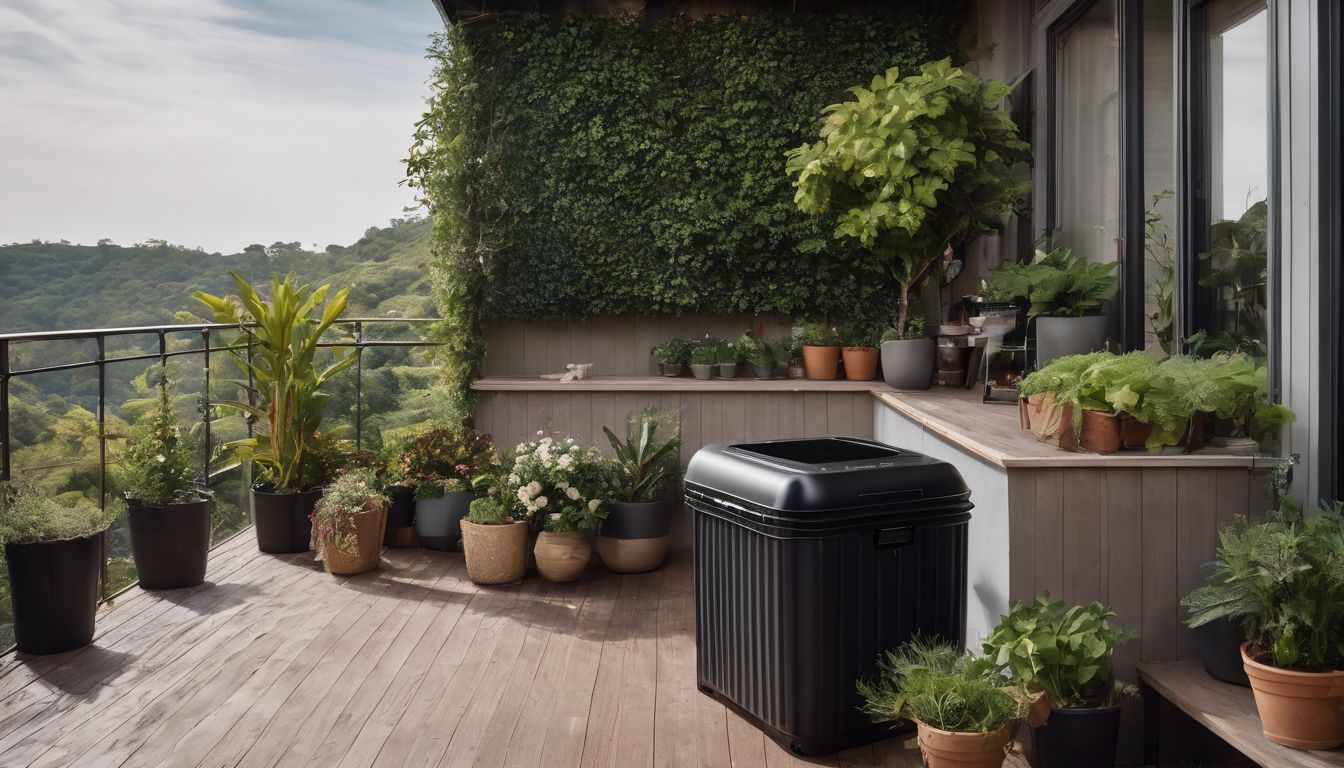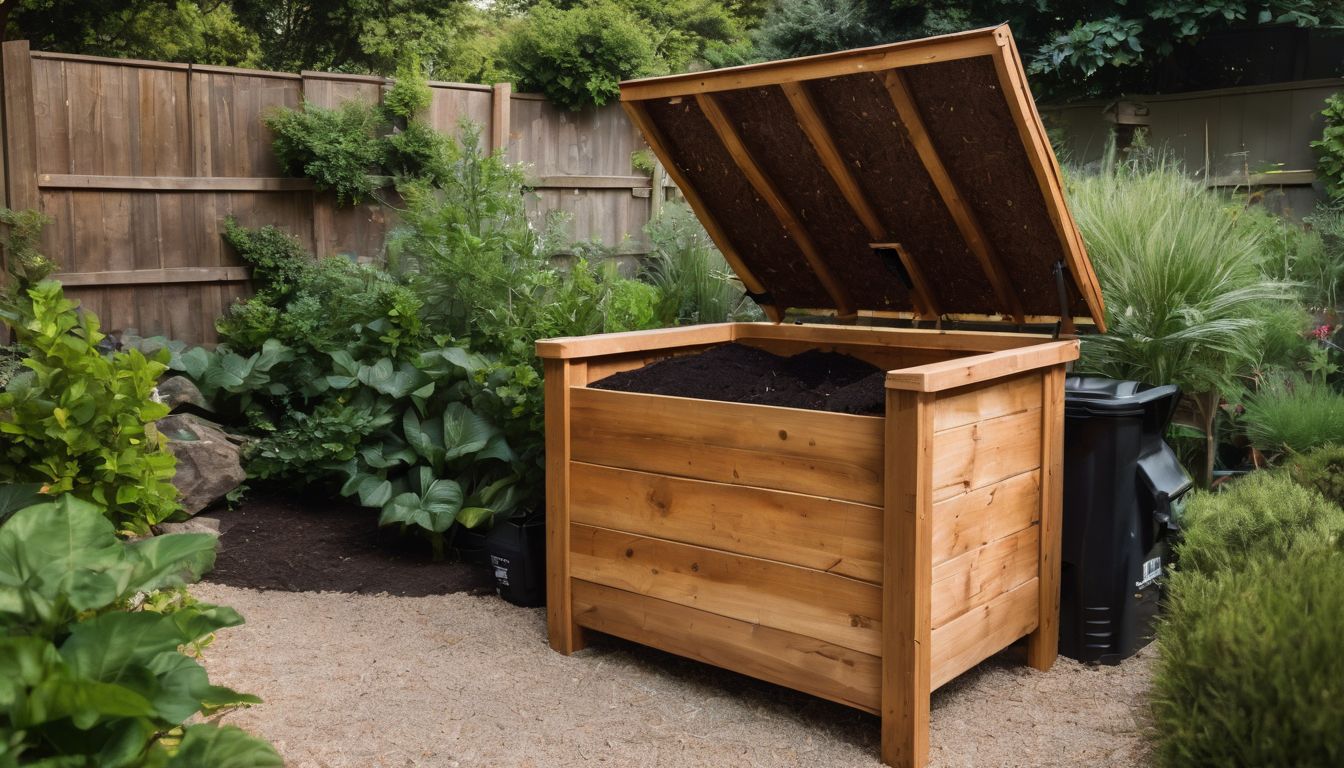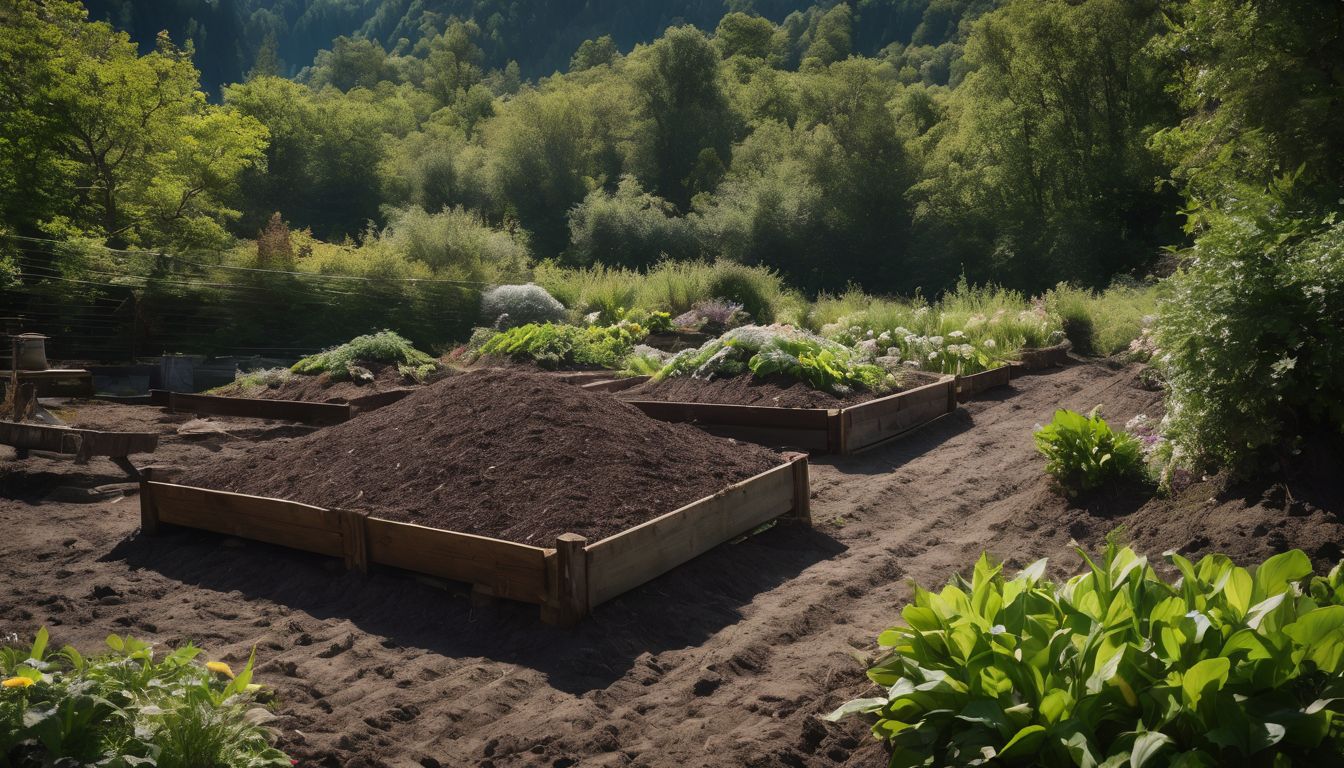Are your container plants not thriving as well as they should be? Compost could be the missing ingredient. Did you know that composting is an easy and effective way to improve soil fertility in container gardening? In this article, we will explore the benefits of using compost, and provide tips on how to make and use it for sustainable garden nutrition. Get ready to take your container gardening to the next level with the power of compost!
Key Takeaways
- Compost provides essential nutrients to plants in container gardening, improving soil structure and plant health.
- You can make your own compost using a mix of green materials like kitchen scraps and brown materials such as leaves, turning it regularly for proper decomposition.
- Utilising compost reduces waste by recycling organic material into valuable fertiliser, aligning with sustainable gardening practices.
- Avoid adding items like meat, dairy, diseased plants or pet waste to your compost pile to prevent attracting pests and creating bad odours.
- Mixing compost with potting soil boosts nutrient content while topdressing containers with compost encourages strong growth and flowering.
Importance of compost for container gardening
Compost acts as a superfood for container gardens, delivering a spectrum of essential nutrients to your plants. This natural soil conditioner fosters a healthy growing environment, crucial in the confined space of pots and planters where soil nutrients can quickly deplete.
By mixing compost into your potting mix, it not only feeds your plants but also improves soil structure, aiding in moisture retention and root penetration.
Sustainable gardening practices benefit greatly from adding compost to container setups. It recycles organic waste into valuable fertiliser, cutting down on environmental impact while boosting garden nutrition.
For urban gardeners working within limited spaces, this approach maximises the productivity of every square inch used for raising vegetables and ornamentals alike. Leading into how this invaluable resource is created—next we explore how to make and use compost effectively in our gardens.
Common misconceptions about compost
Many people mistakenly believe that composting is too complex and messy for urban gardening. They assume it will attract pests and produce unpleasant odours, deterring them from starting their own compost pile.
However, with proper management of organic matter, such as regular turning and balancing green and brown materials, these issues can be avoided easily. Another misconception is that compost alone cannot provide all the necessary nutrients for plant growth in container gardens.
In reality, well-decomposed compost offers a nutrient-rich soil amendment vital for healthy plants, contributing to both macro and micronutrients needed for thriving gardens.
Others think only large spaces can accommodate a compost setup, yet methods like vermicomposting are perfect for small spaces such as balconies or patios. This form of recycling plant material turns kitchen scraps into garden nutrients without needing an expansive yard.
As we move on to discuss how to make your own compost at home successfully, keep in mind that even modest efforts towards soil enrichment are steps towards environmental sustainability.
How to Make and Use Compost
Create compost by combining organic materials such as food scraps, yard waste, and paper with a balance of carbon and nitrogen, then use the nutrient-rich compost in container gardening to improve soil quality and promote healthy plant growth.
Want to learn more about the benefits of using compost in container gardening? Keep reading!
Materials needed for compost
To create nutrient-rich compost, you will need the following materials:
- Organic plant material such as vegetable scraps, fruit peels, and yard waste.
- Brown material like dried leaves, shredded newspaper, or cardboard for carbon balance.
- A compost bin or pile to contain the organic matter and promote decomposition.
- Water to keep the compost moist for microbial activity.
- A pitchfork or garden shovel for turning and aerating the compost.
Steps to create compost
To create nutrient-rich compost for container gardening, follow these simple steps:
- Collect organic waste such as fruit and vegetable scraps, coffee grounds, eggshells, and yard trimmings.
- Layer the organic materials in a compost bin or pile, alternating between green materials like kitchen scraps and brown materials like leaves or shredded paper.
- Keep the compost pile moist by watering it regularly to facilitate decomposition.
- Turn the compost with a pitchfork or shovel every few weeks to aerate it and speed up the decomposition process.
- Monitor the temperature of the compost pile; it should reach 130-150°F (54-66°C) to ensure effective breakdown of materials.
- After 4 – 6 months, when the compost is dark, crumbly, and earthy smelling, it’s ready to use in container gardening.
How to use compost in container gardening
Benefits of Using Compost
Compost enriches the soil with essential nutrients, leading to improved plant growth and overall health. It also supports sustainable gardening practices by recycling plant materials and reducing waste.
Nutrient-rich soil
Compost creates nutrient-rich soil, providing essential nourishment for plants in container gardens. Earthworms and microorganisms break down organic matter into valuable nutrients such as nitrogen, phosphorus, and potassium, promoting healthy plant growth without the need for synthetic fertilisers.
This sustainable gardening practice supports conservation efforts by recycling plant materials to enrich the soil.
Using compost in container gardening enhances the vitality of plants while reducing reliance on chemical fertilisers, contributing to a more environmentally friendly approach to cultivation.
Nutrient-rich soil fosters robust root systems and vigorous foliage, resulting in bountiful harvests from your container garden.
Improved plant growth and health
Using compost in container gardening leads to improved plant growth and overall health. The nutrient-rich soil provided by compost helps plants to thrive, producing stronger stems, luscious foliage, and vibrant blooms.
With the organic matter found in compost, plants are better equipped to resist diseases and pests.
The enhanced microbial activity in the soil due to the presence of compost encourages robust root development, allowing plants to efficiently absorb water and essential nutrients. This results in healthier and more resilient plants that are better able to withstand environmental stresses such as drought or extreme temperatures.
Sustainable gardening
Improved plant growth and health go hand in hand with sustainable gardening. By utilising compost, not only do you enhance the nutrient content of your soil, but also reduce waste by recycling organic materials.
This approach fosters a more environmentally conscious and sustainable garden while promoting gardening sustainability and organic gardening practices.
Moreover, sustainable gardening embraces the concept of plant material recycling as well as raised bed gardening to create a self-sufficient ecosystem within your containers. It encourages a mindful approach towards fertilising, topdressing, and utilising vermicompost to enrich your container garden’s soil health without compromising environmental conservation efforts.
Composting Dos and Don’ts
When composting, it is important to include green and brown materials such as fruit peels, coffee grounds, and dry leaves. Avoid adding meat, dairy products, or diseased plants to your compost pile.
What to include in compost
To create nutrient-rich compost, include the following organic materials:
- Fruit and vegetable scraps
- Coffee grounds and filters
- Eggshells
- Grass clippings and plant trimmings
- Shredded paper and cardboard
- Yard waste like leaves and small branches
What to avoid in compost
Avoid adding meat, dairy, or oily foods to your compost as they can attract pests and create unpleasant odours. Refrain from including diseased plants or weeds with mature seeds that can spread in your garden. Also, avoid putting in pet waste, as it may contain harmful pathogens and parasites that can affect your plants. Furthermore, steer clear of adding non-biodegradable materials such as plastic or metal items that will not break down and will contaminate the compost. Lastly, avoid placing large quantities of acidic materials like citrus fruits or onion peels, as they can throw off the pH balance of the compost.
Tips and Tricks for Utilising Compost in Container Gardening
Mix compost with potting soil to improve the nutrient content, topdress your containers with a layer of compost to promote healthy plant growth, and consider using vermicompost for added benefits.
Mixing compost with potting soil
To enhance the quality of your potting soil, blend compost into it. This process enriches the soil with vital nutrients, promoting plant growth and health. Ensure proper mixing so that the compost is evenly distributed throughout the potting soil.
One method is to combine equal parts of compost and potting soil before adding to your containers. Alternatively, layering the bottom portion of the container with a mix of compost and potting soil can also be effective.
Be sure to gently mix these layers when planting to ensure an even distribution in order for your plants to thrive.
Topdressing with compost
Topdressing with compost involves spreading a layer of compost on the soil surface around plants in containers. This process helps to enrich the soil and provide essential nutrients to the plants, promoting healthy growth and vibrant blooms.
By topdressing with compost, you can improve water retention, prevent erosion, and suppress weed growth in your container garden.
When you topdress with compost, it is important to ensure that the layer is not too thick, as this may lead to excessive moisture retention or cause damage to delicate plant stems.
Additionally, mix the topdressed compost into the upper layers of soil gently to allow for better integration and absorption by plant roots. To enhance nutrient availability further, consider using organic liquid fertilisers along with topdressing for an extra boost of plant nutrition.
Using vermicompost
Vermicompost, produced by earthworms consuming organic waste, is an excellent addition to container gardening. The nutrient-rich soil created by these hardworking creatures promotes healthy plant growth and boosts the overall vitality of your plants.
Mixing vermicompost with potting soil offers a sustainable way to enhance the fertility and structure of the growing medium, resulting in luscious greenery that benefits from increased nutrients and improved water retention.
Utilising vermicompost as a topdressing on container plants helps maintain soil moisture levels while providing continuous nourishment to the growing plants. This environmentally-friendly practice not only supports conservation efforts but also contributes to sustainable gardening practices that benefit both the environment and your garden.
Conclusion
Utilising compost in container gardening can significantly improve the health and growth of your plants, while also supporting sustainable gardening practices. Read on to discover how you can make the most of compost in your own container garden.
Encouraging others to utilise compost in gardening
Encouraging fellow gardeners to embrace composting can significantly contribute to sustainable and nutrient-rich soil for their plants. By using compost, individuals can reduce waste, support conservation efforts, and improve the health of their gardens.
Emphasising the benefits of compost – such as providing essential nutrients to plants, retaining moisture in the soil, and reducing the need for chemical fertilisers – can inspire others to adopt this eco-friendly practice.
Additionally, sharing practical tips for incorporating compost into gardening routines can empower environmentally conscious individuals to take actionable steps towards sustainable and flourishing container gardens.
Promoting the use of compost not only elevates gardening experiences but also aligns with a commitment to environmental stewardship. Encouraging others in utilising this natural resource fosters a sense of community around sustainable practices while reaping bountiful harvests without compromising on ecological responsibility.
FAQs
1. Why should I use compost in my container garden?
Compost provides essential nutrients to your plants and improves the soil quality in your containers.
2. How much compost should I add to my container garden?
Generally, you can mix about one-third of compost with potting soil for a healthy container garden.
3. Can I make my own compost for container gardening?
Yes, you can create your own compost by recycling kitchen scraps and yard waste into nutrient-rich material for your plants.
4. Does compost replace the need for regular potting soil in containers?
No, compost is used to enrich potting soil, not to replace it completely; they work best when combined.
5. How often should I add more compost to my containers?
You might want to add fresh compost to your container gardens every planting season or whenever you change or replenish the plants.





